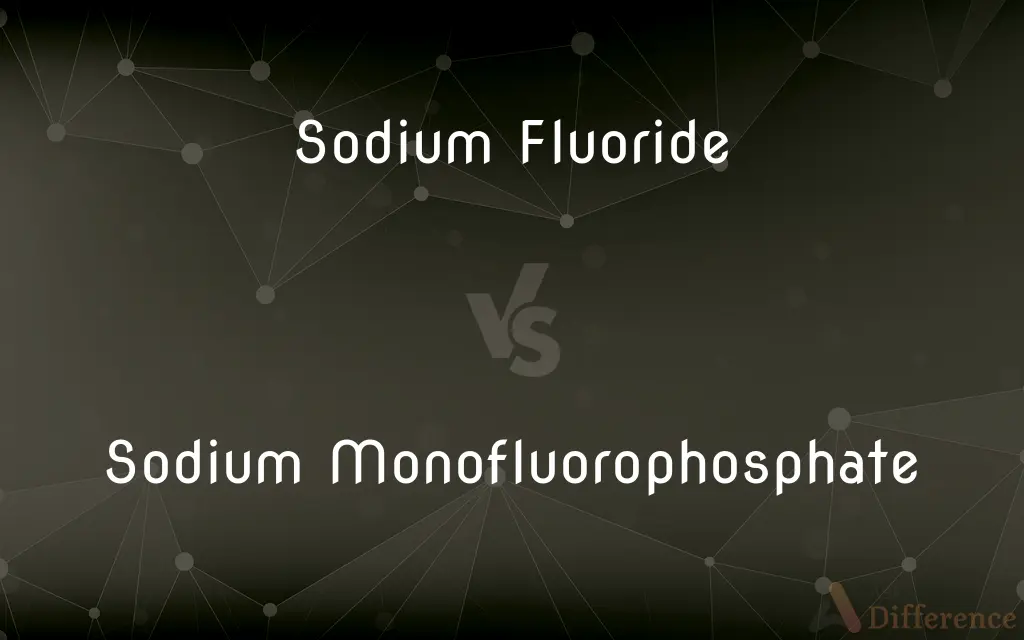Sodium Fluoride vs. Sodium Monofluorophosphate — What's the Difference?
By Tayyaba Rehman — Published on November 23, 2023
Sodium Fluoride is a direct fluoride agent for dental care, while Sodium Monofluorophosphate, also providing fluoride, is often used in toothpaste formulations for anti-cavity purposes.

Difference Between Sodium Fluoride and Sodium Monofluorophosphate
Table of Contents
ADVERTISEMENT
Key Differences
Sodium Fluoride stands as a stalwart in the realm of dental health, recognized for its capacity to prevent dental cavities and enhance enamel strength. It works by encouraging remineralization of decayed tooth areas and inhibiting the bacteria in dental plaque. Sodium Fluoride can be found in various forms, such as toothpaste, mouthwash, and even in professional treatments at dental offices, serving as a protective barrier against tooth decay.
Sodium Monofluorophosphate, conversely, carves its niche in oral care products, such as toothpaste, providing a source of fluoride to aid in the protection against tooth decay. Sodium Monofluorophosphate contributes fluoride ions, vital in tooth remineralization, thereby combating cavity formation and tooth decay. It delivers its benefits without compromising the stability of the toothpaste, ensuring that fluoride remains active and effective throughout the shelf-life of the product.
While both Sodium Fluoride and Sodium Monofluorophosphate provide commendable defense against dental cavities, their mechanisms and formulations differentiate them notably. Sodium Fluoride does so through a direct fluoride ion mechanism that immediately provides free fluoride ions when introduced into the oral cavity. This direct method of action serves to promptly influence the remineralization of teeth and inhibit enamel-demineralizing bacteria.
In contrast, Sodium Monofluorophosphate releases its fluoride ions in a slightly indirect manner. Sodium Monofluorophosphate requires enzymatic action from the enzyme phosphatase, found in saliva, to liberate the fluoride ions and make them available for tooth remineralization. This difference in fluoride ion delivery is one of the fundamental distinctions between these two fluoride compounds in dental care applications.
In essence, Sodium Fluoride and Sodium Monofluorophosphate both serve as pivotal players in preventing dental cavities and enhancing oral health, albeit through slightly different mechanisms and formulations. Both of them supply fluoride ions to the oral environment, which is vital for remineralizing enamel and combating tooth decay, however, their application and mechanism to deliver fluoride distinguish them within dental care applications.
ADVERTISEMENT
Comparison Chart
Fluoride Ion Release
Direct
Indirect (requires enzymatic action)
Common Use
Toothpaste, mouthwash, professional dental treatments
Typically found in toothpaste
Ionic Form
NaF
Na2PO3F
Mechanism
Directly supplies fluoride ions
Supplies fluoride ions via enzymatic release
Compatibility with Abrasives
Sometimes less compatible
Often more compatible
Compare with Definitions
Sodium Fluoride
A fluoride compound.
Sodium Fluoride helps prevent dental cavities.
Sodium Monofluorophosphate
Requires enzymatic activation.
Sodium Monofluorophosphate releases fluoride with the help of saliva enzymes.
Sodium Fluoride
Found in oral care products.
My toothpaste contains Sodium Fluoride to strengthen enamel.
Sodium Monofluorophosphate
Contributes to tooth remineralization.
Toothpaste with Sodium Monofluorophosphate aids enamel repair.
Sodium Fluoride
Direct fluoride ion source.
Sodium Fluoride provides immediate fluoride ions for tooth protection.
Sodium Monofluorophosphate
A toothpaste fluoride source.
Sodium Monofluorophosphate in toothpaste helps prevent cavities.
Sodium Fluoride
Can be a topical treatment.
Sodium Fluoride gel aids in remineralizing tooth surfaces.
Sodium Monofluorophosphate
Combats dental decay.
Sodium Monofluorophosphate actively fights against tooth decay.
Sodium Fluoride
Used in dentistry.
The dentist applied a Sodium Fluoride varnish to protect my teeth.
Sodium Monofluorophosphate
Stable in toothpaste formulations.
Sodium Monofluorophosphate ensures stable fluoride levels in my toothpaste.
Common Curiosities
Does Sodium Monofluorophosphate need enzymatic action?
Yes, it requires saliva enzyme phosphatase.
Can Sodium Fluoride directly provide fluoride?
Yes, it releases fluoride ions directly.
Are Sodium Fluoride and Sodium Monofluorophosphate safe?
Yes, when used in recommended amounts.
Can I get Sodium Fluoride treatments at the dentist?
Yes, professionals often provide treatments.
Can Sodium Fluoride be used in mouthwash?
Yes, it is often used in fluoride mouthwashes.
Does Sodium Monofluorophosphate work against plaque bacteria?
It works primarily by aiding remineralization.
Is Sodium Fluoride effective against cavities?
Yes, it helps prevent cavity formation.
Can children use Sodium Monofluorophosphate toothpaste?
Yes, in age-appropriate formulations and quantities.
Is Sodium Fluoride used in water fluoridation?
Yes, it is commonly used for that purpose.
Is Sodium Monofluorophosphate effective in enamel repair?
Yes, it contributes to remineralization.
Can Sodium Monofluorophosphate stabilize toothpaste?
Yes, it provides stable fluoride in formulations.
Can excessive Sodium Fluoride be harmful?
Yes, overexposure may cause dental fluorosis.
Is Sodium Monofluorophosphate only in toothpaste?
Mostly, due to its stability in such products.
Are Sodium Fluoride and Sodium Monofluorophosphate different ions?
Yes, their ionic structures are different.
Can Sodium Fluoride and Sodium Monofluorophosphate be used together?
Rarely, as formulations typically use one source.
Share Your Discovery

Previous Comparison
Chrysocolla vs. Turquoise
Next Comparison
Contrary vs. DownsideAuthor Spotlight
Written by
Tayyaba RehmanTayyaba Rehman is a distinguished writer, currently serving as a primary contributor to askdifference.com. As a researcher in semantics and etymology, Tayyaba's passion for the complexity of languages and their distinctions has found a perfect home on the platform. Tayyaba delves into the intricacies of language, distinguishing between commonly confused words and phrases, thereby providing clarity for readers worldwide.














































